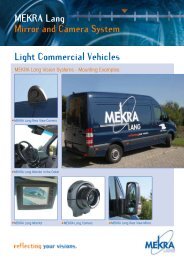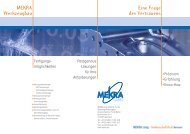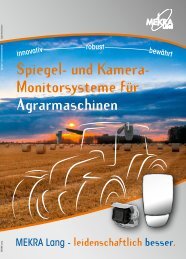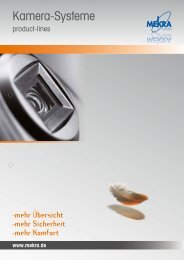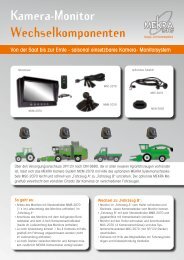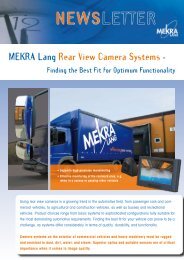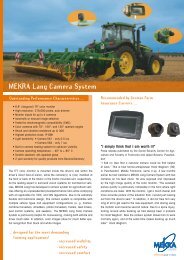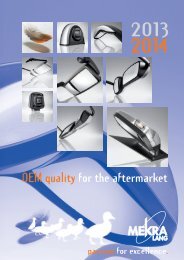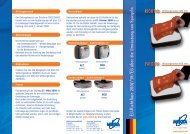DLG Test Report - MEKRA Lang
DLG Test Report - MEKRA Lang
DLG Test Report - MEKRA Lang
Create successful ePaper yourself
Turn your PDF publications into a flip-book with our unique Google optimized e-Paper software.
<strong>MEKRA</strong> <strong>Lang</strong> GmbH & Co. KG<br />
Agricultural Mirror 1009 with Auxiliary Mirror<br />
Field of Vision<br />
<strong>DLG</strong> <strong>Test</strong> <strong>Report</strong> 6039 F<br />
Brief Description<br />
The tested product, <strong>MEKRA</strong> Agricultural Mirror 1009, is a rear-view<br />
mirror specifically designed for use with agricultural vehicles.<br />
This class II mirror is ECE-certified (No. E1-021165) and features an<br />
auxiliary close-proximity mirror.<br />
<strong>DLG</strong> e.V.<br />
<strong>Test</strong>zentrum<br />
Technik und Betriebsmittel<br />
Manufacturer and Applicant<br />
<strong>MEKRA</strong> <strong>Lang</strong> GmbH & Co. KG<br />
Buchheimer Straße 4 – D-91465 Ergersheim<br />
Germany<br />
Phone: +49 (0)9847 989-0<br />
Fax: +49 (0)9847 989-112<br />
www.mekra.de<br />
<strong>DLG</strong> <strong>Test</strong> <strong>Report</strong> 6039F Page 1 of 4
<strong>Test</strong> Results<br />
Class II minimum requirement<br />
Class V minimum requirement<br />
<strong>MEKRA</strong><br />
<strong>MEKRA</strong> auxiliary mirror<br />
Original<br />
Figure 2:<br />
Representation of the various fields of vision<br />
Figure 3:<br />
Side view from cab<br />
The test was conducted in two<br />
parts. The field of vision of the<br />
main mirror was determined<br />
and then compared to the legal<br />
requirements.<br />
The resulting measurements are<br />
shown in Figure 2.<br />
The dark blue line indicates the<br />
legal requirement for class II<br />
main mirrors and hence represents<br />
the minimum required<br />
field of vision as 100%.<br />
The vehicle‘s original mirror<br />
(yellow line in Figure 2) already<br />
provided a larger field of vision<br />
than required. The area captured<br />
by the mirror exceeds the legal<br />
requirement by approximately<br />
50%.<br />
The tested <strong>MEKRA</strong> <strong>Lang</strong> mirror<br />
(dark green line in Figure 2) provides<br />
double the visibility already<br />
at the start of the visible area<br />
and continues to do so across<br />
the entire field of vision. Hence<br />
the visible area exceeds the legal<br />
requirement by 100%.<br />
The tested <strong>MEKRA</strong> <strong>Lang</strong> mirror<br />
also features a special add-on.<br />
In addition to the legally required<br />
class II mirror, it is equipped<br />
with a small auxiliary mirror for<br />
close-proximity applications.<br />
<strong>DLG</strong> <strong>Test</strong> <strong>Report</strong> 6039F Page 2 of 4
Its specific task is to capture the<br />
area next to the two rear wheels<br />
which are not directly visible.<br />
As opposed to trucks, farm and<br />
forestry tractors are not legally<br />
required to carry this type of mirror<br />
(class V). Therefore the light<br />
blue line in Figure 2 representing<br />
the legal requirement for class V<br />
mirrors is for illustrative purposes<br />
only. The light green field of<br />
vision for the small auxiliary mirror<br />
shown in Figure 2 does not<br />
completely cover the front area,<br />
but this is not significant for field<br />
tractors, since this area is directly<br />
visible through the lower part of<br />
the doors.<br />
The auxiliary mirror does, however,<br />
completely close the visibility<br />
gap up to where the legally<br />
required field of vision begins,<br />
which is particularly important<br />
for this type of vehicle, since it is<br />
specifically the area to the side<br />
of the front wheels which cannot<br />
be directly seen from within the<br />
cab. As depicted in Figures 3 and<br />
4, persons and objects next to<br />
the rear wheels can be detected<br />
using the auxiliary mirror.<br />
Summary: The <strong>MEKRA</strong> <strong>Lang</strong><br />
rear-view mirror offers almost<br />
double the legally required field<br />
of vision. The auxiliary mirror is<br />
an excellent enhancement, since<br />
it captures the area directly to<br />
the side of the vehicle. This is<br />
particularly helpful and a safety<br />
advantage when maneuvering in<br />
tight areas and in all areas where<br />
children and other persons may<br />
be present. This was confirmed<br />
by a brief practical experiment.<br />
The larger field of vision provides<br />
significant safety gains. Based<br />
on the above-mentioned results<br />
the use of this mirror is highly<br />
recommended.<br />
Derived fields of vision:<br />
Standard mirror field of vision<br />
Main mirror field of vision<br />
<strong>MEKRA</strong> modular mirror<br />
Close-proximity field of vision<br />
<strong>MEKRA</strong> modular mirror<br />
Figure 4:<br />
Enhanced field of vision provided by the <strong>MEKRA</strong> <strong>Lang</strong> mirror<br />
<strong>DLG</strong> <strong>Test</strong> <strong>Report</strong> 6039F Page 3 of 4
<strong>Test</strong> Results<br />
The <strong>DLG</strong> “field of vision” focus<br />
test determines the effect of the<br />
rear-view mirror.<br />
Mirrors are tested in accordance<br />
with the requirements of ECE<br />
Regulation R46 and European Directive<br />
2003/97/EC, respectively.<br />
The above-mentioned regulatory<br />
requirements address various<br />
mirror classses.<br />
The main mirror field of vision is<br />
assessed according to procedures<br />
for mirror class II. The small<br />
auxiliary mirror is tested according<br />
to procedures for mirror<br />
class V which is dedicated to<br />
close-proximity mirrors. For<br />
testing purposes, the mirror is<br />
attached to a test vehicle and<br />
the field of vision is determined<br />
based on the corresponding<br />
configuration.<br />
The tractor’s driver’s seat represents<br />
point zero for measurements<br />
along the x-axis. The y-axis<br />
starts at the vehicle’s outer edge.<br />
The visible area starts 4 m behind<br />
the driver’s seat at a width of 1<br />
m and then opens up into a cone<br />
shape towards the back.<br />
<strong>Test</strong> Station<br />
<strong>DLG</strong> e.V.,<br />
<strong>Test</strong>zentrum<br />
Technik und Betriebsmittel<br />
Max-Eyth-Weg 1<br />
64823 Groß-Umstadt<br />
Germany<br />
<strong>Report</strong>er<br />
Dipl.-Ing. (FH) O. Thamm<br />
<strong>Test</strong> Execution<br />
Peter Saal<br />
ENTNAM – European Network for <strong>Test</strong>ing of Agricultural Machines is the network<br />
of European testing stations. Its aim is to provide farmers, dealers of agricultural<br />
machines and manufacturers across Europe with test results.<br />
For additional information, please visit www.entam.com, or send an email to<br />
info@entam.com<br />
11-642<br />
October 2011<br />
©<strong>DLG</strong><br />
<strong>DLG</strong> e.V.,<strong>Test</strong>zentrum Technik und Betriebsmittel<br />
Max-Eyth-Weg 1, D-64823 Groß-Umstadt, Germany, Phone: +49 (0)69 24788-600,<br />
Fax: +49 (0)69 24788-690, email: tech@dlg.org, website: www.dlg-test.de<br />
For a free download of all <strong>DLG</strong> test reports, go to www.dlg-test.de!<br />
<strong>DLG</strong> <strong>Test</strong> <strong>Report</strong> 6039F<br />
Page 4 of 4



